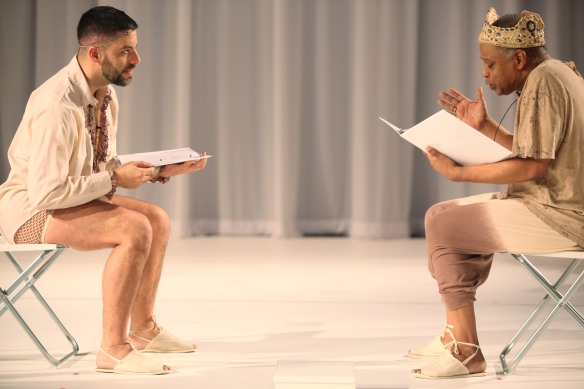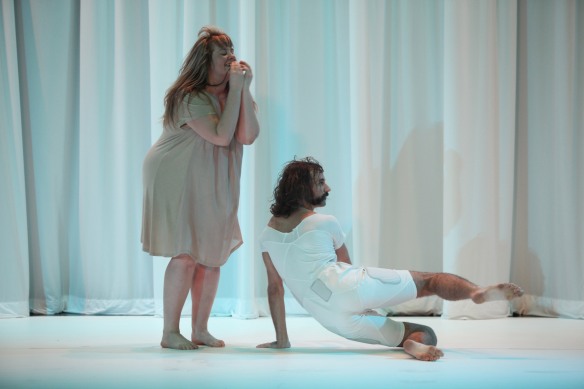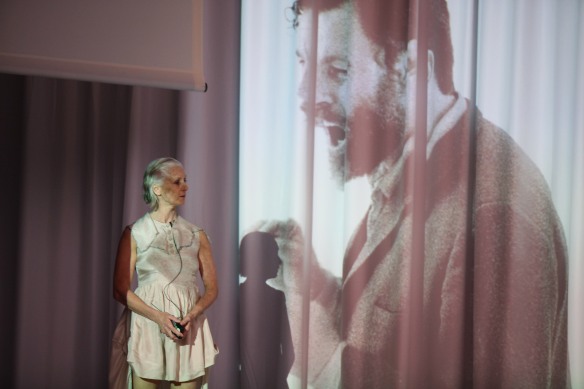BAM Fisher
December 5, 2012
Miguel Guttierez writes on his website, “I make performances that are about things and are things themselves. The things they are about are big…” His latest work, And lose the name of action, lives up to this pronouncement, taking on the relationships between perception and reality, mind and body. The performance’s title is heady in its inspiration as well, drawn from the final lines of Hamlet’s “To be or not to be” speech. In an eloquent program note, Guttierez explained the performance’s genesis—his father’s neurological problems—and his subsequent research into neurological and philosophical perspectives on the relationship of the body and its interactions to perception. He was surprised however, that dance and somatic practices were not generally part of these inquiries, and sought to address this gap in the creation of this piece.
However, And lose the name of action was not nearly as cerebral or theory-heavy as its premise made it sound. The performance was an ever-shifting mélange of dance, song, speech, improvisation, and recorded sound and images, which took place on a white floor, surrounded by white curtains, projection screens, and a glowing white parachute hanging from the ceiling. Having previously voiced his frustration at the way that thin, young, pretty, female, and white seemed to have become the default attributes for those considered dancers, Guttierez assembled an experienced cast of six performers (Michelle Boulé, Hilary Clark, Luke George, K.J. Holmes, Ishmael Houston-Jones, and himself) of varying ethnicities, sizes, and ages. What’s more, these performers were never used in ways that reduced them to these characteristics.
The pure-dance sections of the piece were often initiated or advanced by commands from Guttierez: “stop,” “pause,” “shift,” “and,” “and,” “and.” On one level, this is the language of dance class or of rehearsal, coming from a director or choreographer, but within the context of this performance it also highlighted the relationship between movement and language. “And” as an utterance can connect the words of a sentence, but it can also connect and initiate movements.
The performance frequently investigated the slipperiness of language, or suspicion regarding its meaning. An actor, Paul Duncan, at times appeared projected on the white screens, waxing philosophical in a suit and a British accent. What a contrast between his crisp, buttoned-up presentation and that of the dancers: messy, and unstructured, appearing in revolving a mix of crowns, winter coats, gowns, t-shirts, underwear, or nothing at all. His words were at times taken up by the performers, as if in conversation; at other times, they were severed from his image through a disorienting delay between the sound and the two screens.
Early on, in a parody of 1960’s or 70’s era audience participation performance techniques, Houston-Jones, holding court in a robe and crown in the center of the space, asked us, in an exaggeratedly instructional tone, to place our feet firmly on the ground and join hands with the people next to us. The invitation was met with laughter and good-natured participation (we even connected across the aisles!). The other performers, seated among us in designated white chairs in the front rows, joined in, and were drawn into ecstatic thrall as the lights dimmed, the volume increased, and Houston-Jones summoned some sort of deity from the billowing parachute above.
While the tongue-in-cheek quality of this section was played up, it was nonetheless one of the most enjoyable parts of the evening. This was one of the few times we as audience members were able to directly partake in the experiential nature of Guttierez’s choreography, which is at the heart of his research interests. In the program notes, he writes about “a choreographic mode of perception where meaning is not an analytical proposition but an experiential one.” What deserves further exploration in this work is the differences in perception between audience members and performers: while both might be engaging with meaning on an experiential level, that experience differs depending on whether one is watching or performing.
Toward the end of the piece, Guttierez and Houston-Jones (later joined by the other performers) enacted a philosophical debate on the nature of perception. As if actors rehearsing a play, they held binders and read their dialogue in a stagey manner. Their faux-seriousness was intermittently pierced by synchronized bursts of laughter, at increasingly unlikely points. How seriously were we to follow their interchange? Were we watching (or listening) for the content of their banter or for the performance of the debate? The back-and-forth eventually devolved into a loud cacophony of “fuck you”s and “you believe your senses. Don’t be such an idiot!” as the performers chased each other around the room in anger.

Miguel Guttierez and Ishmael Houston-Jones in “And lose the name of action”
Photo Credit: Julieta Cervantes
The final sections began to drag a bit, as we grew accustomed to these juxtapositions of language and physicality, theory and presence. This type of sensory and intellectual overload seems more effective in (slightly) smaller doses. As we sat listening to the man on the screen repeat “You’re blank,” the stage manager poked in to say “thank you,” notifying us of the show’s conclusion (there were no curtain calls).
Probing complex theoretical issues without allowing them to overtake or overshadow the bodily presence of performers, Gutierrez and his cast shifted ambiguously between the ironic and the earnest. While his lofty inquiries about the relationship between perception and reality, body and mind, and movement and language were only intermittently evident to the audience, there was still much to admire and enjoy in this unpredictable work, brimming over with ideas and images.

